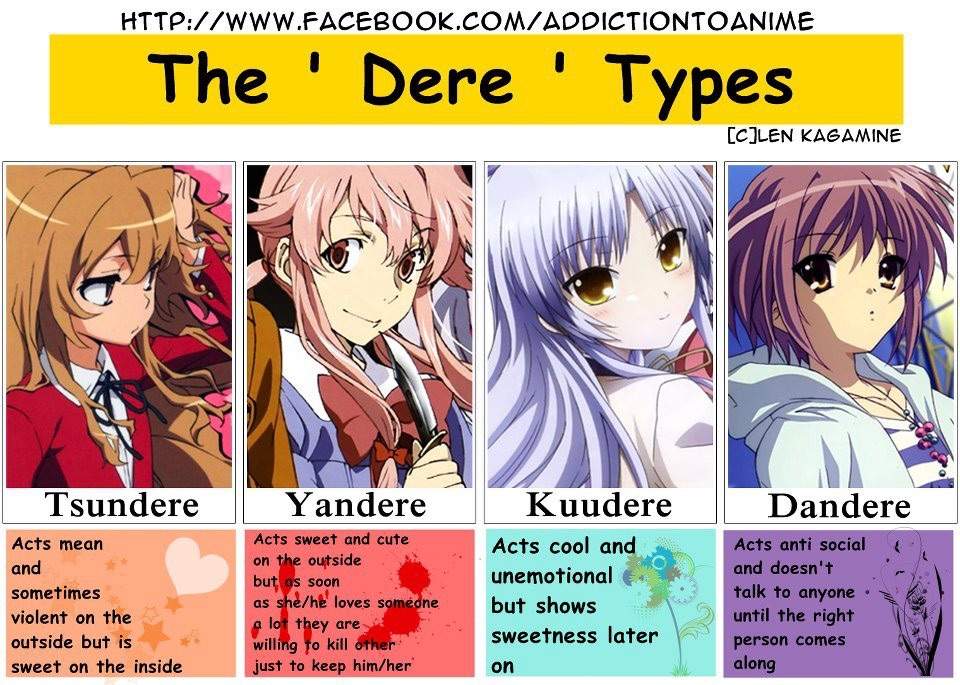Understanding Dere Types In Anime
Ever found yourself captivated by the complexities of fictional romances? The intricate dance of affection and aloofness, sweetness and hostility, has a name: the world of "dere" types. These character archetypes, born from Japanese popular culture, offer a fascinating lens through which we can explore the multifaceted nature of love and attraction.
The term "dere" itself originates from the Japanese word "deredere" (), a mimetic word used to describe someone who is lovestruck and overly affectionate. Think lovey-dovey, head-over-heels, hopelessly smitten. But the real magic happens when "dere" is combined with other prefixes, creating a whole spectrum of romantic personalities. These "dere types" offer a nuanced vocabulary for understanding the push and pull of romantic relationships, adding depth and intrigue to fictional characters.
| Dere Type | Meaning | Characteristics |
|---|---|---|
| Tsundere | Combines "tsun tsun" (cold, aloof) and "deredere" (lovestruck) | Initially cold and hostile, gradually warming up and showing affection. Often uses harsh words but performs acts of kindness. |
| Yandere | Combines "yanderu" (sick, mentally unstable) and "deredere" (lovestruck) | Initially sweet and loving, but possessiveness and obsessive behavior emerge. Can become violent or harmful to protect their love interest. |
| Kuudere | Combines "cool" () and "deredere" (lovestruck) | Calm, composed, and emotionally distant. Expresses affection subtly, often through actions rather than words. |
| Dandere | Combines "danmari" (silent, taciturn) and "deredere" (lovestruck) | Quiet and shy, often introverted. Opens up and shows affection around their love interest. |
| Deredere | Purely lovestruck and affectionate. | Openly displays affection, showering their love interest with attention and kindness. |
Learn More about Dere Types (Wikipedia)
From the classic tsundere, oscillating between hot and cold, to the chillingly devoted yandere, the dere spectrum encompasses a wide range of romantic expressions. The tsundere, perhaps the most well-known archetype, initially repels their love interest with harsh words and a prickly demeanor (tsun tsun - ), only to reveal a softer, more affectionate side (deredere) as the relationship develops. This push-and-pull dynamic creates a captivating tension that fuels many a romantic storyline.
On the other end of the spectrum lies the yandere, whose love borders on obsession. Initially sweet and devoted, the yandere's affection can quickly turn dark, leading to possessiveness, jealousy, and even violence. This complex and often unsettling archetype explores the darker side of love, highlighting the potential for passion to spiral into something destructive.
The kuudere, in contrast, embodies a cool and collected exterior. Rarely displaying overt emotion, the kuudere expresses affection through subtle gestures and quiet acts of service. Their calm and composed demeanor can be both alluring and frustrating, leaving their love interest to decipher the true depths of their feelings.
Then there's the dandere, the shy and introverted type who struggles to express their emotions. Often silent and reserved, the dandere blossoms around their love interest, revealing a hidden wellspring of affection. Their quiet devotion and gradual opening up can be incredibly endearing, creating a heartwarming and relatable portrayal of love.
And finally, the deredere, the embodiment of pure, unadulterated affection. Openly expressive and relentlessly cheerful, the deredere showers their love interest with attention and kindness. Their unwavering positivity and genuine affection can be both refreshing and overwhelming, offering a glimpse into the joys of uncomplicated love.
Beyond these core archetypes, a plethora of fan-created dere types have emerged, further expanding the nuanced language of love in fiction. From the sadodere, who derives pleasure from teasing their love interest, to the kamidere, who demands adoration and respect, the possibilities are endless. This ever-evolving landscape of dere types reflects the creativity and passion of fans, who continue to explore the intricacies of romantic relationships through the lens of these captivating archetypes.
The prevalence of dere types in anime, manga, and other forms of Japanese media speaks to their enduring appeal. They provide a framework for understanding different approaches to love and relationships, adding depth and complexity to characters. Whether you're a seasoned anime fan or simply curious about the phenomenon, exploring the world of dere types offers a fascinating glimpse into the diverse ways we experience and express love.
These archetypes not only enrich fictional narratives but also offer a playful and engaging way to analyze real-life relationships. While real people rarely fit neatly into a single category, the dere framework provides a vocabulary for understanding the nuances of human interaction. Perhaps you recognize a bit of tsundere in your friend's playful banter, or a touch of kuudere in your partner's quiet affection. The dere types, in their exaggerated and often comedic portrayals, offer a fun and insightful way to navigate the complexities of love in all its forms.
The evolution of dere types mirrors the evolution of Japanese pop culture itself. Originating in Bishjo games, these character archetypes have permeated anime, manga, novels, and even real-world interactions. Their continued popularity speaks to their resonance with audiences, offering a compelling and nuanced exploration of the human heart.
So, the next time you encounter a character whose affections are shrouded in mystery or expressed with a touch of playful cruelty, remember the world of dere types. These fascinating archetypes offer a unique perspective on the complexities of love, inviting us to explore the spectrum of human connection in all its messy, beautiful glory.


